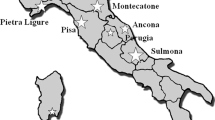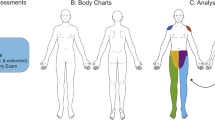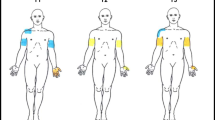Abstract
Study design:
Retrospective register study.
Objective:
To investigate the predictive value of the following parameters for the development of neuropathic pain after non-traumatic spinal cord lesion: that is age at onset of spinal cord disease, gender, completeness of lesion, level of lesion, and aetiology.
Setting:
A unit for patients with post-acute traumatic and non-traumatic spinal cord lesions in the greater area of Stockholm, Sweden.
Method:
All patients with non-traumatic spinal cord lesions visiting the unit between 1995 and 2000 were classified according to the following: that is neuropathic pain at or below lesion level according to IASP criteria, age at time of the onset of the spinal cord symptoms, injury level, complete/incomplete injury, and aetiology. Results were analysed with χ2 – analysis and logistic regression.
Results:
In total, 38% had neuropathic pain, 15% had pain predominantly at the level of lesion, and 23% predominantly below the level of lesion. Of those with pain, 67% reported that the pain affected daily life. Women reported neuropathic pain below the level of lesion more often (40%) than men (13%). The prevalence was particularly high (64%) for patients with malignant spinal cord diseases. Neither age at onset of the spinal cord symptoms, nor complete/incomplete injury nor injury level had significant influence on the prevalence.
Conclusion:
Neuropathic pain is common among patients with acquired non-traumatic spinal cord lesions regardless of aetiology, often causing severe problems in daily life.
Similar content being viewed by others
Log in or create a free account to read this content
Gain free access to this article, as well as selected content from this journal and more on nature.com
or
References
Frisbie JH . Spinal cord lesions caused by arteriovenous malformation: clinical course and risk of cancer. J Spinal Cord Med 2002; 25: 284–288.
Kirshblum SC, Groah SL, McKinley WO, Gittler MS, Stiens SA . Spinal cord injury medicine. 1. Etiology, classification, and acute medical management. Arch Phys Med Rehabil 2002; 83 (3 Suppl 1): S50–S57, S90–S98.
McKinley WO, Seel RT, Hardman JT . Nontraumatic spinal cord injury: incidence, epidemiology, and functional outcome. Arch Phys Med Rehabil 1999; 80: 619–623.
McKinley WO, Tewksbury MA, Mujteba NM . Spinal stenosis vs traumatic spinal cord injury: a rehabilitation outcome comparison. J Spinal Cord Med 2002; 25: 28–32.
New PW, Rawicki HB, Bailey MJ . Nontraumatic spinal cord injury: demographic characteristics and complications. Arch Phys Med Rehabil 2002; 83: 996–1001.
Ragnarsson KT, Lammertse DP . Rehabilitation in spinal cord disorders. 2. Anatomy, pathogenesis, and research for neurologic recovery. Arch Phys Med Rehabil 1991; 72: S295–S297.
Salvador de la Barrera S, Barca-Buyo A, Montoto-Marques A, Ferreiro-Velasco ME, Cidoncha-Dans M, Rodriguez-Sotillo A . Spinal cord infarction: prognosis and recovery in a series of 36 patients. Spinal Cord 2001; 39: 520–525.
Celani MG, Spizzichino L, Ricci S, Zampolini M, Franceschini M . Spinal cord injury in Italy: a multicenter retrospective study. Arch Phys Med Rehabil 2001; 82: 589–596.
Exner G, Meinecke FW . Trends in the treatment of patients with spinal cord lesions seen within a period of 20 years in German centers. Spinal Cord 1997; 35: 415–419.
Guttmann L . Spinal Cord Injuries: Comprehensive Management and Research. Oxford: Blackwell 1973, p. 627.
Maharaj JC . Epidemiology of spinal cord paralysis in Fiji: 1985–1994. Spinal Cord 1996; 34: 549–559.
Bonica JJ . Introduction: semantic, epidemiologic, and educational issues. In: Casey KL (ed). Pain and Central Nervous System Disease: The Central Pain Syndromes. New York: Raven Press 1991, pp 13–29.
Siddall PJ, Loeser JD . Pain following spinal cord injury. Spinal Cord 2001; 39: 63–73.
Finnerup NB, Johannesen IL, Sindrup SH, Bach FW, Jensen TS . Pain and dysesthesia in patients with spinal cord injury: a postal survey. Spinal Cord 2001; 39: 256–262.
Segatore M . Understanding chronic pain after spinal cord injury. J Neurosc Nurs 1994; 26: 230–236.
Levi R, Hultling C, Seiger A . The Stockholm Spinal Cord Injury Study: 2. Associations between clinical patient characteristics and post-acute medical problems. Paraplegia 1995; 33: 585–594.
Werhagen L, Budh CN, Hultling C, Molander C . Neuropathic pain after traumatic spinal cord injury – relations to gender, spinal level, completeness, and age at the time of injury. Spinal Cord 2004; 42: 665–673.
Ditunno JF, Donovan WH, Maynard FM . ASIA. In: Ditunno JFDWHM, FM (ed). Reference Manual for the International Standards for Neurological and Functional Classification of Spinal Cord Injury. ASIA: Chicago 1994.
Siddall JP, Yezierski RP, Loeser JD . Pain following spinal cord injury: Clinical features, prevalence, and taxonomy. Technical corner from IASP Newsletter 2000.
Siddall PJ, Taylor DA, Cousins MJ . Classification of pain following spinal cord injury. Spinal Cord 1997; 35: 69–75.
Siddall PJ, McClelland JM, Rutkowski SB, Cousins MJ . A longitudinal study of the prevalence and characteristics of the pain in the first 5 years following spinal cord injury. Pain 2003; 103: 249–557.
Yule SM, Hide TA, Cranney M, Simpson E, Barrett A . Low grade astrocytomas in the West of Scotland 1987–96: treatment, outcome, and cognitive functioning. Arch Dis Child 2001; 84: 61–64.
Berkley KJ . Sex differences in pain. Behav Brain Sci 1997; 20: 371–380 discussion 435–513.
Norrbrink-Budh C et al. Gender related differences in pain in spinal cord injured individuals. Spinal Cord 2003; 41: 122–128.
Anke AG, Stenehjem AE, Stanghelle JK . Pain and life quality within 2 years of spinal cord injury. Paraplegia 1995; 33: 555–559.
Acknowledgements
We thank Mr Jakob Bergström at the Department of Learning, Informatics, Management and Ethics (Lime) at the Karolinska Institute for statistical support, and Mrs Aileen Bergström, occupational therapist at the Uppsala University Hospital for linguistic revision. We also convey our appreciation to assistant professor Rickard Levi for being crucial and instrumental in establishing the database for spinal cord injured patients in the greater Stockholm area. Without that initiative this study would not have been made.
Author information
Authors and Affiliations
Rights and permissions
About this article
Cite this article
Werhagen, L., Hultling, C. & Molander, C. The prevalence of neuropathic pain after non-traumatic spinal cord lesion. Spinal Cord 45, 609–615 (2007). https://doi.org/10.1038/sj.sc.3102000
Published:
Issue date:
DOI: https://doi.org/10.1038/sj.sc.3102000
Keywords
This article is cited by
-
Relationships between cardiovascular disease risk, neuropathic pain, mental health, and autonomic function in chronic spinal cord injury
Spinal Cord (2023)
-
The demographics of pain after spinal cord injury: a survey of our model system
Spinal Cord Series and Cases (2022)
-
Pain characteristics in Italian people with spinal cord injury: a multicentre study
Spinal Cord (2022)
-
Adverse cognitive effect of gabapentin in individuals with spinal cord injury: preliminary findings
Spinal Cord Series and Cases (2018)
-
Spinal cord injury in older population in Turkey
Spinal Cord (2014)



